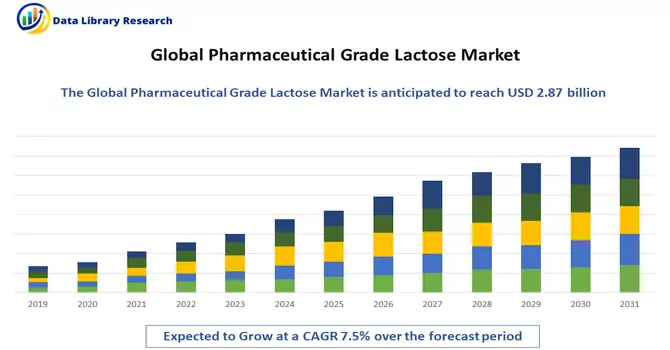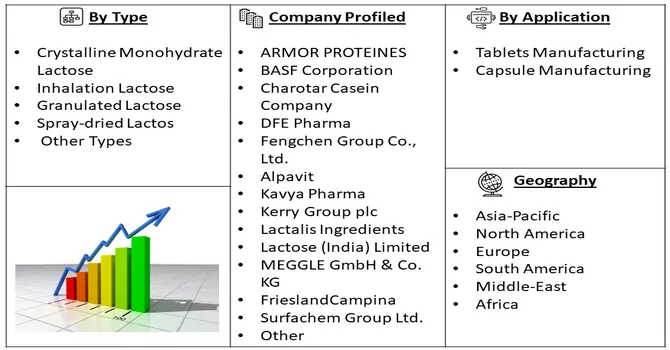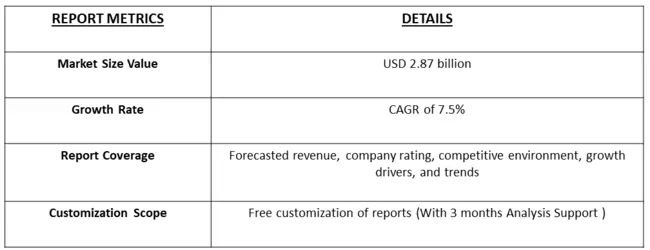The global pharmaceutical grade lactose market size was estimated at USD 2.87 billion in 2023 and is projected to grow at a compound annual growth rate (CAGR) of 7.5% from 2024 to 2031.

Get Complete Analysis Of The Report - Download Free Sample PDF
Pharmaceutical grade lactose is a high-quality, pure form of lactose that meets stringent standards and specifications set for pharmaceutical applications. Derived from cow's milk, this lactose undergoes thorough processing and purification to ensure it meets the rigorous quality and safety requirements essential for pharmaceutical formulations. It serves as a key excipient in the pharmaceutical industry, commonly used in the manufacturing of tablets and capsules as a binder and filler. Pharmaceutical grade lactose is characterized by its low moisture content, excellent compressibility, and high chemical and physical stability. Its consistent quality and compliance with pharmaceutical regulations make it an essential ingredient in the production of pharmaceutical formulations, facilitating drug delivery, stability, and patient safety.
The pharmaceutical grade lactose market experiences robust growth driven by the escalating demand for pharmaceuticals worldwide, particularly as the pharmaceutical manufacturing sector expands to meet healthcare needs. With a surge in chronic diseases and an aging population, pharmaceutical grade lactose, utilized as a binder and filler in oral solid dosage forms, becomes integral to medication production. Advancements in drug formulations, a focus on patient-centric dosage forms, and the popularity of generic drugs further contribute to the market's momentum. Additionally, continuous investments in pharmaceutical research and development foster innovation, creating opportunities for pharmaceutical grade lactose in new and improved drug formulations. The market's dynamic growth is underscored by its pivotal role in supporting diverse pharmaceutical applications, reflecting its significance in the evolving landscape of medication development and manufacturing.
Market Segmentation: The global pharmaceutical grade lactose market is Segmented by Type (Crystalline Monohydrate Lactose, Inhalation Lactose, Granulated Lactose, Spray-dried Lactose, and Other Types) and Geography (North America, Europe, Asia-Pacific, South America, and Africa). The market size and forecast are provided in terms of value (USD million) for the above segments.

For Detailed Market Segmentation - Download Free Sample PDF
The pharmaceutical grade lactose market is witnessing notable trends that shape its trajectory and future developments. Increased emphasis on personalized medicine and patient-centric drug delivery systems is driving a shift towards innovative formulations, boosting the demand for pharmaceutical grade lactose as an essential excipient. Growing investments in research and development are fostering the development of specialized drug delivery technologies, such as orally disintegrating tablets, creating new opportunities for pharmaceutical grade lactose applications. Moreover, the industry is witnessing a surge in the adoption of continuous manufacturing processes, prompting manufacturers to seek excipients with enhanced flow properties, further propelling the market. Additionally, the rise of sustainable and high-performance excipients aligns with the broader industry trend towards environmentally conscious practices, influencing the choice of pharmaceutical grade lactose in formulations. As the pharmaceutical landscape evolves, these trends collectively reflect the dynamic nature of the pharmaceutical grade lactose market, showcasing its adaptability and significance in shaping the future of pharmaceutical formulations.
Market Drivers:
Increasing Pharmaceutical Manufacturing
The burgeoning pharmaceutical industry, fueled by escalating global healthcare demands and the increasing prevalence of chronic diseases, plays a pivotal role in driving the demand for pharmaceutical grade lactose. As pharmaceutical companies strive to address the growing health challenges, the need for high-quality excipients like pharmaceutical grade lactose intensifies. Its critical role as a versatile excipient in tablet and capsule formulations, where it acts as a binder and filler, proves instrumental in the production of oral solid dosage forms. This application not only ensures the structural integrity of pharmaceutical formulations but also facilitates the controlled release of active ingredients, enhancing drug efficacy. The growth of pharmaceutical grade lactose, driven by its indispensable role in supporting the manufacturing of essential oral medications, aligns with the dynamic landscape of the pharmaceutical industry and its commitment to meeting global healthcare needs with innovative and effective solutions.
Focus on Patient-Centric Dosage Forms
The pharmaceutical industry's shift towards patient-centric dosage forms is a key driver propelling the demand for pharmaceutical grade lactose. As the industry places a heightened emphasis on enhancing patient adherence and overall experience, orally disintegrating tablets and capsules have gained prominence due to their user-friendly nature. Pharmaceutical grade lactose, with its unique properties, serves as an ideal excipient for formulating these dosage forms. Its compatibility with the manufacturing processes of orally disintegrating tablets ensures that these medications dissolve rapidly in the mouth without the need for water, offering convenience to patients, especially those with difficulty swallowing traditional tablets. Additionally, pharmaceutical grade lactose's role in creating capsules aligns with the trend of developing dosage forms that are easy to administer and enhance patient compliance. The growth in demand for pharmaceutical grade lactose, driven by its suitability for crafting these user-centric formulations, underscores the industry's commitment to providing innovative and accessible medication options tailored to patient preferences and needs.
Market Restraints:
Complexity in Manufacturing
The production of pharmaceutical grade lactose involves intricate manufacturing processes to meet stringent quality, purity, and regulatory standards. This complexity can pose a significant restraint, particularly for smaller manufacturers in the pharmaceutical industry. Ensuring consistent quality throughout the manufacturing process is crucial, demanding sophisticated equipment, precise control over environmental conditions, and adherence to Good Manufacturing Practices (GMP). The purification and refining steps required to achieve pharmaceutical grade standards are technically demanding and necessitate specialized knowledge. Moreover, maintaining purity is paramount in pharmaceutical grade lactose production to prevent any contaminants that could compromise the safety and efficacy of medications. Compliance with regulatory standards, such as those set by health authorities like the U.S. Food and Drug Administration (FDA) and the European Medicines Agency (EMA), adds an additional layer of complexity. Smaller manufacturers may face challenges in navigating and implementing these intricate regulatory requirements, which often entail rigorous documentation, quality control measures, and facility validations. Thus, such factors are expected to slow the growth of the studied market.
The COVID-19 pandemic has had a nuanced impact on the pharmaceutical grade lactose market. While the pharmaceutical industry has experienced heightened demand for medications and treatments, disruptions in supply chains, logistics, and workforce availability have affected the overall production and distribution of pharmaceutical excipients, including pharmaceutical grade lactose. The pandemic-induced challenges, such as lockdowns, travel restrictions, and increased focus on healthcare priorities, have influenced the dynamics of the pharmaceutical grade lactose market. On one hand, the surge in pharmaceutical manufacturing to address the health crisis has driven demand for excipients, including lactose; on the other hand, disruptions in the supply chain and operational constraints have created challenges in meeting this increased demand. The market has witnessed a push for more resilient and diversified supply chains, and an increased focus on regulatory compliance and quality assurance as the industry adapts to the ongoing challenges posed by the pandemic.
Segmental Analysis:
Crystalline Monohydrate Lactose Segment is Expected to Witness Significant Growth over the Forecast Period
Crystalline Monohydrate Lactose, a specific form of pharmaceutical grade lactose, plays a crucial role in the pharmaceutical industry as a versatile excipient. Recognized for its high quality, purity, and compatibility with various drug formulations, Crystalline Monohydrate Lactose serves as a key ingredient in the production of oral solid dosage forms. Its unique properties, including excellent compressibility and stability, make it an ideal choice for tablet and capsule formulations, contributing to the structural integrity and controlled release of active pharmaceutical ingredients. The Pharmaceutical Grade Lactose Market, encompassing Crystalline Monohydrate Lactose, is witnessing growth driven by increased pharmaceutical manufacturing, advancements in drug formulations, and the industry's focus on patient-centric dosage forms. However, challenges such as regulatory compliance, production complexity, and the impact of external factors like the COVID-19 pandemic shape the landscape of this market, emphasizing the need for resilient and adaptable strategies within the pharmaceutical excipient sector.
North America Region is Expected to Witness Significant Growth over the Forecast Period
The pharmaceutical-grade lactose market in the North America region is marked by robust growth driven by the flourishing pharmaceutical industry, increasing demand for advanced drug formulations, and a focus on patient-centric dosage forms. The region's pharmaceutical sector, characterized by continuous research and development activities, contributes significantly to the demand for high-quality excipients like pharmaceutical-grade lactose. Factors such as the rising prevalence of chronic diseases and the popularity of generic drugs further propel the market. However, challenges related to regulatory compliance and the complexity of manufacturing processes may influence the market dynamics. The North America pharmaceutical-grade lactose market remains dynamic, shaped by a balance between technological advancements, stringent regulatory standards, and the evolving needs of the pharmaceutical industry.

Get Complete Analysis Of The Report - Download Free Sample PDF
The analyzed market exhibits a high degree of fragmentation, primarily attributable to the presence of numerous players operating on both a global and regional scale. The competitive landscape is characterized by a diverse array of companies, each contributing to the overall market dynamics. This fragmentation arises from the existence of specialized solution providers, established industry players, and emerging entrants, all vying for market share. The diversity in market participants is underscored by the adoption of various strategies aimed at expanding the company presence. On a global scale, companies within the studied market are strategically positioning themselves through aggressive expansion initiatives. This often involves entering new geographical regions, targeting untapped markets, and establishing a robust global footprint. The pursuit of global expansion is driven by the recognition of diverse market opportunities and the desire to capitalize on emerging trends and demands across different regions. Simultaneously, at the regional level, companies are tailoring their approaches to align with local market dynamics. Regional players are leveraging their understanding of specific market nuances, regulatory environments, and consumer preferences to gain a competitive edge. This regional focus allows companies to cater to the unique needs of local clientele, fostering stronger market penetration. To navigate the complexities of the fragmented market, companies are implementing a range of strategies. These strategies include investments in research and development to stay at the forefront of technological advancements, mergers and acquisitions to consolidate market share, strategic partnerships for synergies, and innovation to differentiate products and services. The adoption of such multifaceted strategies reflects the competitive nature of the market, with participants continually seeking avenues for growth and sustainability. In essence, the high fragmentation in the studied market not only signifies the diversity of players but also underscores the dynamism and competitiveness that drive ongoing strategic maneuvers. As companies explore various avenues for expansion, the market continues to evolve, presenting both challenges and opportunities for industry stakeholders.
Key Pharmaceutical Grade Lactose Companies:
Recent Developments:
1) In February 2023, MEGGLE GmbH & Co. KG undertook a significant expansion of its distribution network by entering exclusive agreements with key distributors, exemplified by its strategic partnership with Barentz for the distribution of pharmaceutical-grade lactose in the U.S. This move reflects MEGGLE's proactive approach to strengthening its market presence and enhancing accessibility to its high-quality pharmaceutical lactose products. By collaborating with exclusive distributors, MEGGLE aims to optimize its reach and ensure efficient supply chain management, ultimately benefiting its customers in the pharmaceutical industry. The partnership with Barentz highlights a strategic alignment to leverage each partner's strengths, fostering a robust distribution network in the U.S. market. These initiatives collectively underscore MEGGLE's commitment to industry leadership, innovation, and meeting the growing demand for pharmaceutical-grade lactose. As a result, MEGGLE is strategically positioned to play a major and influential role in shaping the landscape of lactose distribution within the pharmaceutical sector.
2) In September 2022, DFE Pharma marked a significant expansion of its operations with the inauguration of a new Center of Excellence in India, demonstrating the company's commitment to serving its customers in the region. This strategic move positions DFE Pharma to better cater to the specific needs of the Indian market, fostering closer collaborations and understanding of local requirements. The establishment of a Center of Excellence not only signifies a physical presence but also emphasizes a commitment to excellence in product development, customer support, and industry advancements. Moreover, DFE Pharma's proactive approach is evident in its strategic partnerships and collaborations with industry players. By joining forces with key stakeholders, the company aims to accelerate innovations and co-create comprehensive solutions tailored to the evolving needs of its customers. These collaborations not only reflect a dedication to staying at the forefront of industry trends but also underscore DFE Pharma's determination to provide cutting-edge and highly effective solutions to enhance its market presence and customer satisfaction.
Q1. What was the Pharmaceutical Grade Lactose Market size in 2023?
As per Data Library Research the global pharmaceutical grade lactose market size was estimated at USD 2.87 billion in 2023.
Q2. At what CAGR is the Pharmaceutical Grade Lactose Market projected to grow within the forecast period?
Pharmaceutical Grade Lactose Market is projected to grow at a compound annual growth rate (CAGR) of 7.5% over the forecast period.
Q3. Which region has the largest share of the Pharmaceutical Grade Lactose market? What are the largest region's market size and growth rate?
North America has the largest share of the market. For detailed insights on the largest region's market size and growth rate request a sample here.
Q4. Who are the key players in Pharmaceutical Grade Lactose market?
Some key players operating in the market include
Data Library Research are conducted by industry experts who offer insight on industry structure, market segmentations technology assessment and competitive landscape (CL), and penetration, as well as on emerging trends. Their analysis is based on primary interviews (~ 80%) and secondary research (~ 20%) as well as years of professional expertise in their respective industries. Adding to this, by analysing historical trends and current market positions, our analysts predict where the market will be headed for the next five years. Furthermore, the varying trends of segment & categories geographically presented are also studied and the estimated based on the primary & secondary research.
In this particular report from the supply side Data Library Research has conducted primary surveys (interviews) with the key level executives (VP, CEO’s, Marketing Director, Business Development Manager and SOFT) of the companies that active & prominent as well as the midsized organization
FIGURE 1: DLR RESEARH PROCESS

Extensive primary research was conducted to gain a deeper insight of the market and industry performance. The analysis is based on both primary and secondary research as well as years of professional expertise in the respective industries.
In addition to analysing current and historical trends, our analysts predict where the market is headed over the next five years.
It varies by segment for these categories geographically presented in the list of market tables. Speaking about this particular report we have conducted primary surveys (interviews) with the key level executives (VP, CEO’s, Marketing Director, Business Development Manager and many more) of the major players active in the market.
Secondary ResearchSecondary research was mainly used to collect and identify information useful for the extensive, technical, market-oriented, and Friend’s study of the Global Extra Neutral Alcohol. It was also used to obtain key information about major players, market classification and segmentation according to the industry trends, geographical markets, and developments related to the market and technology perspectives. For this study, analysts have gathered information from various credible sources, such as annual reports, sec filings, journals, white papers, SOFT presentations, and company web sites.
Market Size EstimationBoth, top-down and bottom-up approaches were used to estimate and validate the size of the Global market and to estimate the size of various other dependent submarkets in the overall Extra Neutral Alcohol. The key players in the market were identified through secondary research and their market contributions in the respective geographies were determined through primary and secondary research.
Forecast Model
